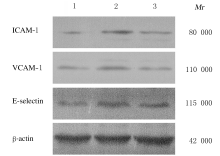| [1] |
Zhanqi ZHAO,Chengjin ZHANG,Juan TIAN.
Inhibitory effect of Ndfip1 on ferrion-induced neuronal apoptosis and its neuroprotective mechanism
[J]. Journal of Jilin University(Medicine Edition), 2021, 47(2): 338-343.
|
| [2] |
Ruili ZHANG,Xiaoqing YANG,Xiaoge ZHANG,Huafeng GUO,Jihong ZHU.
Effect of gestational diabetes mellitus on diaphragmatic function of newborn offsprings of rats
[J]. Journal of Jilin University(Medicine Edition), 2021, 47(1): 133-138.
|
| [3] |
.
Inhibitory effect of curcumin on tumor growth in colorectal cancer mice and its mechanism of PTEN/PI3K/Akt signaling pathwayPEI Yongbin, WANG Guiqi, LI Wei, JIANG Xia, JIANG Haibo, ZHAO Zengren (Department of General Surgery,First Hospital,Hebei Medical University, Shijiazhuang 050031,China)
[J]. Journal of Jilin University(Medicine Edition), 2021, 47(1): 145-151.
|
| [4] |
LIU Luyao, ZHANG Wenwen, CAO Juan, LI Weibo, SUN Hongchen, LI Bo.
Effect of curcumin on gene expressions of cytokines secreted by tumor-associated macrophages
[J]. Journal of Jilin University(Medicine Edition), 2020, 46(05): 930-936.
|
| [5] |
ZHANG Cong, LIU Di, ZHANG Hanxue, ZHANG Hao, KONG Fanli, FENG Xianmin.
Protective effect of ginsenoside on hydrogen peroxide-induced HepG2 cell injury
[J]. Journal of Jilin University(Medicine Edition), 2020, 46(05): 985-991.
|
| [6] |
YANG Fan, LI Lihua.
Effect of vitamin D receptor activation on hepatic fibrosis induced by bile duct ligation in mice and its mechanism
[J]. Journal of Jilin University(Medicine Edition), 2020, 46(04): 722-727.
|
| [7] |
QIN Chao, DAI Xi, YANG Xiaoqiong, WANG Rongli, WANG Xing, LI Guoping.
Intervention effect of honokiol on inflammatory response in lung tissue of asthma mice and its mechanism
[J]. Journal of Jilin University(Medicine Edition), 2020, 46(02): 214-220.
|
| [8] |
ZHOU Yabin, HUA Jin, QI Lingli, DAI Lu, PANG Xiaoli.
Protective effect of curcumin pre-treatment on liver of acute ischemia-reperfusion model rats
[J]. Journal of Jilin University(Medicine Edition), 2020, 46(02): 297-301.
|
| [9] |
GUO Xianghui, ZHENG Hui, WU Wei.
Protetive effects of anemoside B4 on kidney tissue of rats with chronic renal failure and its mechanism
[J]. Journal of Jilin University(Medicine Edition), 2020, 46(01): 90-95.
|
| [10] |
LI Jinhua, JIN Ying, LI Junfeng, LI Li.
Effects of sesamin on abilities of learning and memory in AD model mice and their mechanisms
[J]. Journal of Jilin University(Medicine Edition), 2019, 45(06): 1275-1280.
|
| [11] |
SONG Na, SU Dongfeng, LIU Xiaoyan, GAO Yu, LIU Chang, LI Lihui.
Protective effect of soy isoflavone on oxidative stress injury in perimenopause model rats with type 2 diabetes mellitus
[J]. Journal of Jilin University(Medicine Edition), 2019, 45(06): 1310-1314.
|
| [12] |
ZHAO Miao, WANG Yi, ZHANG Ying, FENG Yumei, CAO Yawen, JIANG Haisen, LI Wei.
Improvement effect of curcumin on cognitive function in mice with sleep deprivation and its mechanism
[J]. Journal of Jilin University(Medicine Edition), 2019, 45(06): 1373-1378.
|
| [13] |
ZHANG Jie, ZHOU Hui, LIU Liang, GUO Guixi, YU Qiang, YIN Pengfei, CHEN Wenqiang, SU Xing.
Effect of knockdown of EphB1 gene on oxidative damage of cardiomyocytes induced by hydrogen peroxide in rats
[J]. Journal of Jilin University(Medicine Edition), 2019, 45(04): 819-824.
|
| [14] |
XU Dongliang, PENG Zhaohui, XIONG Meicai.
Promotion effect of curcumin on implant osseointegration in osteoporosis rats
[J]. Journal of Jilin University(Medicine Edition), 2019, 45(04): 877-881.
|
| [15] |
WANG Ziyan, WANG Zeyu, WANG Guoqiang, GUAN Xuewa, PANG Zhiqiang, GUO Yingqiao, YUAN Yuze, RAN Nan, LIU Yue, WANG Fang.
Therapeutic effects of YiXuanNing Granule on ischemic vertigo of mice and rats and their mechanisms
[J]. Journal of Jilin University(Medicine Edition), 2019, 45(03): 546-550.
|
 )
)





